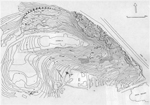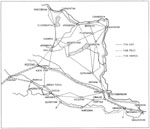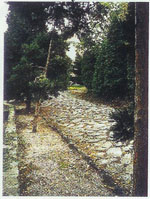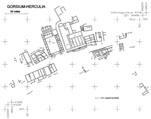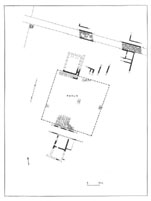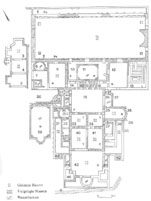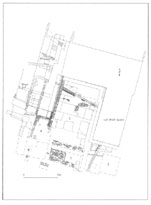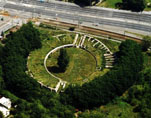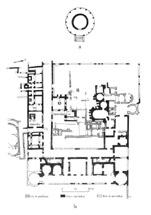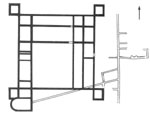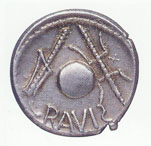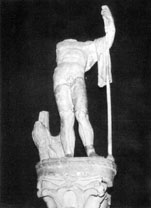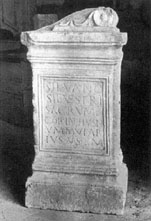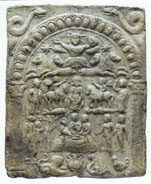Emergence of Civitas capitals in Pannonia
Political structure before the Romans in Pannonia
From the 5th century BC., during the 4th-3rd century
B.C. Celtic tribes settled down in the territory of the Carpathian basin.
The names of the first settled tribes are not known. The scordiscus
tribe appeared in the beginning of the 3rd century B.C., after 279 BC., in
the territory of the confluence of the Danube and the Sava. In the 2nd century
BC., their territory extended to the Dalmatian coast and to the western border
of Thracia. The Pannonian and the Dardan tribes were under their authority
as well. Their Balcan hegemony came to its end in the 80’s BC., when they
were defeated by Scipio Asiagenus. At this time they drew back to the region
of Syrmia, where we meet them in time of the roman conquest.
In 191 BC., from Italy expelled boius tribe migrated to the Danube
(Strabon V,1,6,) and they established their zone of power on the NW-part of
the Carpathian basin, which meant loose alliance of different Celtic tribes
and ethnic groups. This alliance was ceased by the Dacians’ conquest between
60-50 BC.
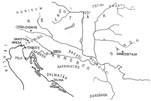 In 45 BC. the boii retreated to NW-Pannonia, after the victory
of the Dacian leader, Boirebistas and the region, which was ruled by them,
became - in the written sources mentioned - deserta boiorum. At this
time, names of different tribes appear in the sources, which lived under the
boius supremacy: in the Danube bend the Eravisci, to south from
them the Hercuniates, to NE from the Danube bend (in the Barbaricum)
the Osi, Cotini, Anartii, Taurisci.
In 45 BC. the boii retreated to NW-Pannonia, after the victory
of the Dacian leader, Boirebistas and the region, which was ruled by them,
became - in the written sources mentioned - deserta boiorum. At this
time, names of different tribes appear in the sources, which lived under the
boius supremacy: in the Danube bend the Eravisci, to south from
them the Hercuniates, to NE from the Danube bend (in the Barbaricum)
the Osi, Cotini, Anartii, Taurisci.
The Pannonians, who gave the latter name of the province, were for the first
time mentioned by the written tradition (Polybios frg. 64=122) in the middle
of the 2nd century BC. The praeceltic group, related to the Illyrians,
lived in the NW-part of the Balkans, and occupied a large territory between
the Drava and the Dardans, resp. the Illyrians living in Dalmatia. On the
streght of the descriptions of Appian and Strabon (Illyr.14.22) they were
divided into several tribes, but only two of them, the Breuci and the
Andizetes lived in the territory of the latter Pannonia. Till the end
of the 2nd century BC, they were under scordiscus authority,
and probably set themselves free in the beginning of the 1st century
BC. In the 60’s BC, they already ruled the valley of the Sava. It is known
by Appian (Illyr.22.) that: „ the Pannonians don’t live in towns, but at their
relations in villages and homesteads, they haven’t got common councils and
common leaders, who stand be the head of them.” The fact, that Segestiké (the
latter Siscia) was several times mentioned in the written sources as a town
in the territory of the Pannonians, which was trying to be occupied in 156
B.C., and 119 B.C., and only in 35 BC. was taken by Octavianus, is inconsistent
with Appian’s description. Before immediately to the roman conquest, in the
region of the Central-Danube the following ethnic groups could be found: east
from the Danube bend the Osi, above them the Cotini and the
Anartii. The Tisza-river (Parisus) was the frontier between the territory
of the Dacians and the Celts. The Boii lived in the territory of the
Lajta-river, south from them the Taurisci
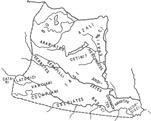 (in the vicinity of Nauportus) and the Breuci between the Drava
and Sava. The region of the present Syrmia was occupied by the Scordisci.
At the time of Caesar’s death there wasn’t such a state, which could have
been dangerous opponent of Rome. The tribes, living in the territory of Pannonia,
were organized into civitas peregrinae, after Pannonia’s conquest,
nor later than the Pannonian tribes’ rebellion (about 10 A.D.). Some name
of the civitas pergrinae with roman origin shows, that they were artificially
established by the Romans and they weren’t original units of tribes. These
names are known by the place-lists of Pliny (NH III, 48) and Ptolemaios. The
gravestones and military diplomas provide more information about the location
of tribes.
(in the vicinity of Nauportus) and the Breuci between the Drava
and Sava. The region of the present Syrmia was occupied by the Scordisci.
At the time of Caesar’s death there wasn’t such a state, which could have
been dangerous opponent of Rome. The tribes, living in the territory of Pannonia,
were organized into civitas peregrinae, after Pannonia’s conquest,
nor later than the Pannonian tribes’ rebellion (about 10 A.D.). Some name
of the civitas pergrinae with roman origin shows, that they were artificially
established by the Romans and they weren’t original units of tribes. These
names are known by the place-lists of Pliny (NH III, 48) and Ptolemaios. The
gravestones and military diplomas provide more information about the location
of tribes.
Native predecessors in Pannonia
As neither it is known much about the centres of civitates – on the one hand it is not known where they situated, on the other hand because of the lack of researches – nor the antecedents can not be in detail discussed. In the middle of the 1st century B.C., in the time of the Dacian-wars, in the territory of the latter Pannonia several fortified, high-altitude settlements were established, which could have corrasponded to the centres of civitates.
The most well-investigated civitas in Pannonia is the civitas Eraviscorum. Both Pliny (NH III, 148) and Ptolemaios (Geogr. II, 15, 3) mention it in the list of the province’s ethnic groups. The name of the civitas, from the end of the 1st century A.D., and the beginning of the 2nd century AD. on several grave-insciptions can be found. Their names in the sources are Eravisci and Aravisci, on their coins they appeared in form of Iravisci and Ravis(ci)
The territory of the civitas Eraviscorum stretched from the Danube bend to the northern part of the Hegyhát, it was separated from the civitas Azaliorum by the ranges of the Pilis and Vértes, in their southern vicinity there was the civitas of the Hercuniates, which occupied the region of the Mecsek and the Hegyhát.
According to the viewpoint of the up-to-date researches, it can be imagined that the eravisci arrived in the territory of the latter Pannonia together with the boii, and they took possession of the Danube bend in the course of the development of the boius’ sphere of power. According to another theory, the tribe crossed the Danube from its northern bank to the territory of the latter civitas in course of the migrations after the Dacian victory in the middle of the 1st century BC. The region between the Danube and the Hills of Buda, because of its favourable geographical site, could be the centre both of the Romans and of the eravisci, which is rightly searched in the attraction-area of the latter centre of the province, Aquincum. On the Gellért-hill, a fortified settlement of refugium character was established to utilizing the good possibilities of river crossing and the advantages of the high-altitude location. On the southern slope of the Gellért-hill, square dug-in houses with rounded corners, waste pits and remains of a factory site were found. The potter-quarter was built at the safest part of the hill, but far away from water and clay resource, which can be probably explained by the Dacian threat. The oppidum could have named after the Celtic supreme god, Teutanus, and it didn't have the name civitas Eraviscorum.
Simultaneously with the oppidum, or not much later, settlements on the flatland at the right river side of the Danube, in larger or smaller distance from each other were established. The settlement of Tabán in the territory of the present Budapest, on the Gellért-hill; the settlement of Lágymányos relatively close to the hill and the settlement of Békásmegyer, north from Aquincum are known owing to the excavations. Their existence in the time of the Marcomannian-wars can not be documented.
On the strength of the extremely moderate finds, it is supposed, that the settlement of the Gellért-hill after fire, was systematically evacuated by the romans. The inhabitants were settled down on the flatland, in the vicinity of the given up, earlier ala-camp of the Víziváros and to south from it. It was frequent to settling native inhabitants in the territory of an earlier military camp or a vicus in Britannia and in Germania Superior as well, where the limes was gradually moved forward. In this way established settlements were directed by duumvir and ordo and sometimes the status of municipium was given as well. The vicus around the ala-camp of Budapest-Víziváros, was not given up by the rearrange of the army, on the contrary, on the basis of the excavated ruins it can be stated, that the vicus was changed into a comparatively extensive settlement, with regular system of roman streets and insulae. To 124 AD., when Aquincum got the status of municipium, this settlement was the most important in this region and it is supposed, that Aquincum with the status of vicus was under its supremacy (RIU 1256). On the basis of inscriptions, which in large number and in the same territory were found, it is proved, that the territory of the civitas was subordinated to the municipium after 124 AD. But the centre of the civitas also existed after the establishment of Aquincum and it depended on Aquincum in a close legally form and a precisely stated way. Their office-holders could have been the members of the ordo of Aquincum, from their Aelius name it is concluded that they got civic rights in the time - or after - of Hadrian. It is proved by an altar from Intercisa, erected for the salvation of the civitas Eraviscorum (RIU 1066). The altar was erected by P. Aelius Septimus and P. Aelius Decoratus, who had the highest status of the municipium, namely decurio and arm(…) c(ivitatis) Er(aviscorum). The ARM abbreviation can be ar(e)m(agos), the celtic name of the princeps. Already in the time of the roman conquest, the princeps were the members of the council, consisted of the civitas’ richest and most noble people, who were the earlier leader group of the tribe. On the basis of the burying, the vicus of the Víziváros was given up in the 4th century AD.
The special position of the civitas Eraviscorum among the pannonian civitates is proved by the fact, that under roman authority, coins with inscription RAVIS were minted in the 20’s BC. The right of minting was in hand of the tribe’s aristocracy. The names on gravestones of the latter romans with eraviscus origin show, that the concept of inheritance was not known. It relates to the existence of the common properties with Iron-Age origin. On the basis of the names it is proved, that the eravisci spoke Celtic language.
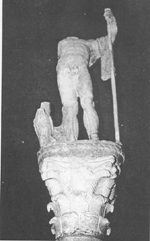
 Teutanus, the supreme god of the Celtic eravisci,
became absorbed in Iuppiter in the imperial period, then after the conquest,
altars and statues were erected with collective name.
On the strength of the Iuppiter Optimus Maximus Teutanus altar-stone (CIL
10418) and several cult-object uncovered in 1888, the native centre of cult
was for long thought to be on the Gellért-hill.
However, on the basis of more finds and the comparisons of Carnuntum-Pfaffenberg,
today it is probable that, the cult-centre was situated to north from the
oppidum, in the territory between the earlier ala-camp and canabae,
on the present Szépvölgyi road. The earliest
uncovered object was set up by T. Flavius Titianus augur for the salvation
of the emperor and the civitas Eraviscorum (CIL 10418), in the time
of Philippus Arabs’ reign (244-249 A.D.). The latest altar, erected for I.O.M.T.,
is known from 288 A.D., and on a two years earlier altar-stone the fines
Eraviscorum was still mentioned. So it proves the legal existence of the
civitas in the end of the 3d century A.D., but in this time, it can be treated
only as a cultic community.
Teutanus, the supreme god of the Celtic eravisci,
became absorbed in Iuppiter in the imperial period, then after the conquest,
altars and statues were erected with collective name.
On the strength of the Iuppiter Optimus Maximus Teutanus altar-stone (CIL
10418) and several cult-object uncovered in 1888, the native centre of cult
was for long thought to be on the Gellért-hill.
However, on the basis of more finds and the comparisons of Carnuntum-Pfaffenberg,
today it is probable that, the cult-centre was situated to north from the
oppidum, in the territory between the earlier ala-camp and canabae,
on the present Szépvölgyi road. The earliest
uncovered object was set up by T. Flavius Titianus augur for the salvation
of the emperor and the civitas Eraviscorum (CIL 10418), in the time
of Philippus Arabs’ reign (244-249 A.D.). The latest altar, erected for I.O.M.T.,
is known from 288 A.D., and on a two years earlier altar-stone the fines
Eraviscorum was still mentioned. So it proves the legal existence of the
civitas in the end of the 3d century A.D., but in this time, it can be treated
only as a cultic community.
Foundation
of the civitas capitals in Pannonia
The tribes, living in the territory of Pannonia, were organized into civitas peregrinae, after Pannonia’s conquest, nor later than the Pannonian tribes’ rebellion (about 10 AD.). Some name of the civitas pergrinas with roman origin shows, that they were artifically established by the romans and they weren’t original units of tribes. The list of place-names written by Pliny (NH III, 48), was compiled relying upon a sheet from the Augustan-period, so it can be referred to the earliest period. Slightly latter was the list of Ptolemaios made, in which can not to be found some civitas mentioned by Pliny (Serretes, Serapilli, Catari, Belgites, Arabiates), but these are supposed to fade into the territories of another civitates. The gravestones and military diplomas provide more information about the location of civitates.
Wooden phases – conversion to stone
Typical buildings in Pannonia
Forum
Basilica
Baths
Mansio
In Aquincum, south from the
southern city wall, a building built together with bath was excavated,
which was probably functioned as a guesthouse as well. It can be identified
as a mansio or deversorium. |
Theatre, amphitheatrum
(1) |
(2) |
(3) |
Temples
Indication
of legal status in Pannonia
Indication of the inhabitants in Pannonia
Indication of cults in Pannonia
ELU
Bibliography
Alföldy 1960 = Alföldy G., Pannoniciani augures. Antik Tanulmányok 7 (1960).
Bodó 2003 = Bodó S. (Hrsg.), Forschungen in Aqincum 1969-2002. Aquincum Nostrum II.2. 2003. Budapest 2003.
Aquincum 1995 = Istenek, katonák, polgárok Aquincumban. Kiállítás az Aquincumi Múzeum megnyitásának 100. évfordulója alkalmából Budapest 1995.
Kovács 1999 = Kovács P., Civitas Eraviscorum. Antaeus 24(1999) 278-295.
Mócsy 1962 = Mócsy A., Pannonia. In: PWRE IX. Stuttgart 1962, 515-776.
Mócsy 1974 = Mócsy A., Pannonia and Upper Moesia. A History of the Middle Danube Provinces of the Roman Empire. London – Boston 1974.
Mócsy 1975a = Mócsy A., Pannonia a korai császárság idején. Budapest 1975.
Mócsy 1975b = Mócsy A., Pannonia a késői császárkorban. Budapest 1975.
Mócsy-Fitz 1990 = Mócsy A./ Fitz J. (szerk.), Pannonia régészeti kézikönyve. Budapest 1990.
Aquincum 2000 = Ókeresztény emlékek Aquincumban. A BTM Aquincumi Múzeumának kamara kiállítása a Millenium alklamából. Budapest 2000.
Póczy 1999 = Póczy K., Iuppiter Optimus Maximus Teutanus Aquincumban. In: Gaál A. (szerk.), Pannoniai kutatások. A Soproni Sándor Emlékkonferencia előadásai (Bölcske, 1998. október 7.). Szekszárd 1999, 201-223.
RCP 1998 = Religions and Cults in Pannonia. A Szent István Király Múzeum Közleményei. Ser. A. No. 33. Székesfehérvár 1998.
Soproni 1990 = Soproni S., Előzetes jelentés a bölcskei késő római ellenerőd kutatásáról. Communicationes Archaeologicae Hungariae 1990, 133-140.
Zsidi 2002 = Zsidi P., Aquincum polgárvárosa. Budapest 2002.
Zsidi 2003 = Zsidi P./ Magyar M., Fürdőépület az aquincumi polgárváros déli városfalán kívül. Aquincumi Füzetek 9 (2003) 69-85.
